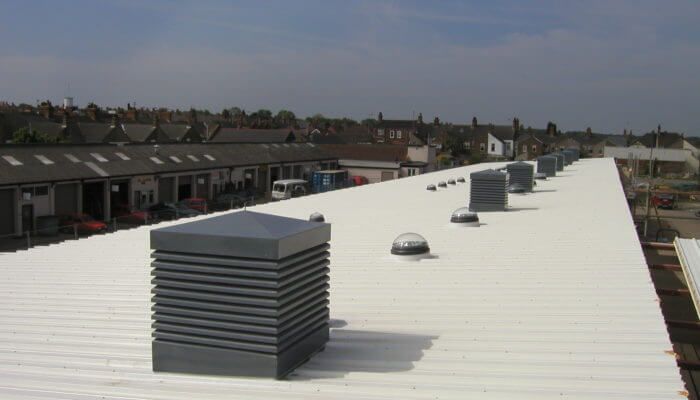Commercial rooflights can bring many benefits to a wide range of commercial and industrial buildings – from shopping centres, hotels and hospitals, to office blocks, factories and warehouses.
Whether you’re looking to enhance the appearance of a building, bring in more light, reduce energy costs, improve working conditions for occupants, or incorporate the latest EN 17037 daylighting standards, commercial rooflights can help.
Why should I consider a commercial rooflight?
Commercial rooflights, along with other glazing options such as tall windows or curtain walling, all help to bring the outdoors in, creating a space that feels more inviting and comfortable.
Natural daylight incorporated into indoor spaces can dramatically reduce energy costs, while also improving performance and the mood of the building occupants. They also create an interesting and aesthetically pleasing architectural feature, making the building more attractive, both inside and out.
Numerous studies have shown increased exposure to natural daylight can help to improve focus, reduce stress, and decrease cases of illness, all resulting in a happier and healthier workforce, while also benefiting other visitors to the building.
In fact, natural light is so important, its provision is incorporated into the new European Standard, EN 17037. The new standard was published at the end of 2018 and provides comprehensive guidance on everything from how to integrate daylight in building design to methods of calculating daylight levels.
Depending on the commercial rooflight you choose, it may also provide natural ventilation, further contributing to the air quality of the building and the overall comfort of occupants.
What are the different types of commercial rooflights?
Commercial rooflights come in a wide range of shapes and sizes – and the right choice will depend on criteria such as roof construction, the amount of light desired and aesthetic preferences. Options include:
● Flat rooflights – These can be used to cover large spaces, providing a considerable amount of daylight. These are often chosen for more modern buildings due to their minimalist appearance, and some products can be installed flush with the roofline. Depending on maintenance and access requirements, these can also be designed in a way that makes them safe for walking on.
● Barrel rooflights – Semi-circular in shape, barrel rooflights are ideal for larger spaces and can even fit together to cover an entire roof.
● Box rooflights – These are often used to enhance natural lighting indoors, while also providing access to roof terraces since they can create the headroom required for staircases.
● Pyramid rooflights – If you’re looking to combine natural lighting with an attractive architectural feature, then a pyramid rooflight might be the best choice. Sometimes called roof lanterns, these create a spotlight-like effect, and are beautiful both inside and outside.
● Dome and tube rooflights – These are usually small rooflights that combine a dome on the outside of the building with a reflective tube that guides light into the building.
We’ve been providing commercial roofing solutions for more than 40 years, and we’ve installed commercial rooflights for an array of commercial and industrial projects, including shopping centres, airports, sports stadia, factories and office buildings.
Can you put a rooflight on a flat roof?
The short answers is yes. As previously discussed, there are many different types of rooflights, and many of them are suitable for flat roof applications, so long as they are correctly installed and adequately weatherproofed.
Depending on the design, some rooflights may require an upstand for installation on a flat roof. Despite its name, a flat roof requires a fall to allow for water drainage and is therefore not truly “flat”. An upstand is the frame that sits around the rooflight, and ensures the rooflight is installed at the right pitch so that rainwater can naturally drain away. Custom-made GRP upstands can be manufactured to suit the specific requirements of your roof and rooflights, and once installed, they offer long lifespans and require minimal maintenance.
Are rooflights a good investment?
In almost every case, as long as the rooflight is installed professionally, the answer is yes. As with all investments using a highly skilled team with experience installing commercial rooflights ensures that planning and execution will keep disruption at an absolute minimum, while the overall gains will benefit the building and its occupants.
Commercial rooflights help to reduce energy use throughout the day, as they provide natural lighting and reduce reliance on electrical lights. Finally the improvements in occupant wellbeing and performance should also be considered and not underestimated when looking at the value of investment.
Do rooflights require maintenance?
If installed correctly, commercial rooflights should require minimal maintenance. This means by an expert that can ensure the rooflight is installed at the right angle, and well-sealed against wind and water ingress. Experts such as the team here at Jones Weatherproofing have extensive experience in installing and weatherproofing rooflights, and all work will be covered by an industry leading 25 year warranty for added peace of mind and long term cost savings.
Choosing commercial rooflights for your next project
If you’re thinking about having commercial rooflights, the next step is to speak with an expert. They will go over the specifics of your project, providing advice and guidance about everything from the ideal shape, size and placement of your rooflight, through to planning permission, installation and maintenance.
As trusted installers of commercial rooflights and other building penetrations, Jones Weatherproofing can create bespoke solutions for even the trickiest designs. To find out more, or to discuss your project, please get in touch.


